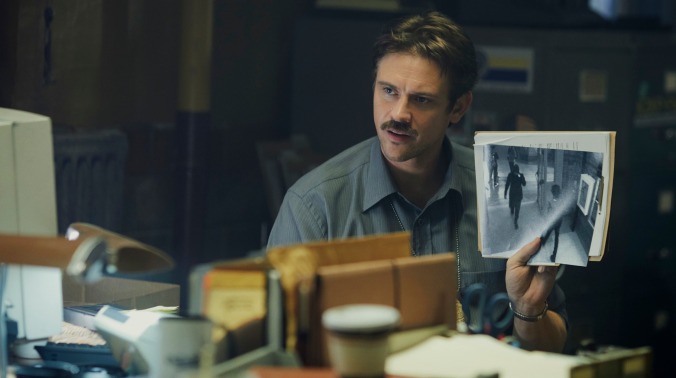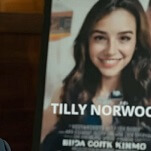Time travel is a conundrum, for theoretical physicists and screenwriters alike. It’s cheaper to convincingly portray than, say, space travel, which makes it an appealing prospect for independent filmmakers looking to stretch their sci-fi dollar as far as possible. But it’s also an incredibly complicated and inherently contradictory concept—so much so that a logically seamless time travel story is, historically speaking, rather rare. In The Shadow Of The Moon, the latest from Stake Land and We Are What We Are director Jim Mickle, unfortunately proves to be the clumsy rule rather than its clever exception.
In The Shadow Of The Moon comes from Netflix, which has stepped in to fund the kind of mid-budget genre films that major studios have all but stopped making. This particular example is a hybrid, blending a gritty crime drama à la Mickle’s own Cold In July with a high-concept sci-fi story about a time-traveling assassin named Rya (Cleopatra Coleman) who’s working her way backwards from the year 2024 to 1988, when she has a fateful encounter with Philadelphia beat cop Locke (Boyd Holbrook). Lock nurses a True Detective-esque, decades-long obsession with this mysterious young woman, who reappears every nine years to kill a handful of people with a gadget that looks like the hilt of a lightsaber and is explained away with some gobbledygook about isotopes and remote detonation. The film is structured around these returns, which have something to do with the moon and which mark the exciting evolution of Holbrook’s facial hair, if not his performance.
The script by Gregory Weidman and Geoffrey Tock not only breaks a core screenwriting rule by telling rather than showing, but it also makes a point to tell in the most convoluted way possible. Laden with hackneyed banter and pseudoscientific jargon but distressingly short on internal logic, this is the kind of movie where a character will say, “If you’ve got a badge on your chest and a gun on your hip, I need you to move right now!” when “calling all units” would do. Add in heavy-handed voice-over at the end of the film that does everything but draw the audience a diagram of what happened over the preceding 110 minutes, and it’s all just too overwritten to take seriously.
This same combination of overindulgence and sloppiness extends to Mickle’s usually-much-tighter direction, which overemphasizes certain details—if you ever forget where (or when) you are, don’t worry, there will be a coffee mug or newspaper or local commercial to remind you within a minute or two—while completely neglecting others. Despite the aggressive Philadelphia-ness of it all, co-star Michael C. Hall randomly has a Southern accent; even worse, that accent comes and goes throughout the film. Most baffling of all is the scene where Locke’s pregnant wife dies, as pregnant wives must in these films, or else we wouldn’t know why the hero is so sad. One moment, she’s fine—or as fine as someone can be while they’re in labor. The next, her head flops to one side, her eyes close, and just like that, she’s gone.
At least the gore is good. Rya’s isotope gizmo has some pretty gnarly effects, causing victims’ brains to liquefy in their skulls and come oozing out of their eyes, ears, and nose along with spurting jets of blood. (Why the poison that actually kills the victims has to be remote activated from the future remains unexplained.) Then again, the opening CGI shot of a skyscraper decimated by a terrorist attack looks like it was rendered 10 years ago, so even the effects are a mixed bag. In The Shadow Of The Moon is a disappointing misfire all around, but no matter—like so many other Netflix original films, it’ll be reabsorbed into the streaming void soon enough.







































